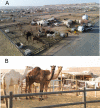High Prevalence of MERS-CoV Infection in Camel Workers in Saudi Arabia
- PMID: 30377284
- PMCID: PMC6212820
- DOI: 10.1128/mBio.01985-18
High Prevalence of MERS-CoV Infection in Camel Workers in Saudi Arabia
Abstract
Middle East respiratory syndrome (MERS), a highly lethal respiratory disease caused by a novel coronavirus (MERS-CoV), is an emerging disease with high potential for epidemic spread. It has been listed by the WHO and the Coalition for Epidemic Preparedness Innovations (CEPI) as an important target for vaccine development. While initially the majority of MERS cases were hospital acquired, continued emergence of MERS is attributed to community acquisition, with camels likely being the direct or indirect source. However, the majority of patients do not describe camel exposure, making the route of transmission unclear. Here, using sensitive immunological assays and a cohort of camel workers (CWs) with well-documented camel exposure, we show that approximately 50% of camel workers (CWs) in the Kingdom of Saudi Arabia (KSA) and 0% of controls were previously infected. We obtained blood samples from 30 camel herders, truck drivers, and handlers with well-documented camel exposure and from healthy donors, and measured MERS-CoV-specific enzyme-linked immunosorbent assay (ELISA), immunofluorescence assay (IFA), and neutralizing antibody titers, as well as T cell responses. Totals of 16/30 CWs and 0/30 healthy control donors were seropositive by MERS-CoV-specific ELISA and/or neutralizing antibody titer, and an additional four CWs were seronegative but contained virus-specific T cells in their blood. Although virus transmission from CWs has not been formally demonstrated, a possible explanation for repeated MERS outbreaks is that CWs develop mild disease and then transmit the virus to uninfected individuals. Infection of some of these individuals, such as those with comorbidities, results in severe disease and in the episodic appearance of patients with MERS.IMPORTANCE The Middle East respiratory syndrome (MERS) is a coronavirus (CoV)-mediated respiratory disease. Virus transmission occurs within health care settings, but cases also appear sporadically in the community. Camels are believed to be the source for community-acquired cases, but most patients do not have camel exposure. Here, we assessed whether camel workers (CWs) with high rates of exposure to camel nasal and oral secretions had evidence of MERS-CoV infection. The results indicate that a high percentage of CWs were positive for virus-specific immune responses but had no history of significant respiratory disease. Thus, a possible explanation for repeated MERS outbreaks is that CWs develop mild or subclinical disease. These CWs then transmit the virus to uninfected individuals, some of whom are highly susceptible, develop severe disease, and are detected as primary MERS cases in the community.
Keywords: Middle East respiratory syndrome; T cells; antibody; camel workers; coronavirus; human Middle East respiratory syndrome; virus-specific T cell response; virus-specific antibody response.
Copyright © 2018 Alshukairi et al.
Figures



References
Publication types
MeSH terms
Substances
Grants and funding
LinkOut - more resources
Full Text Sources
Medical
